South America
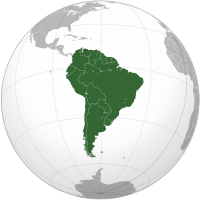 | |
| Area | 17,840,000 km2 (6,890,000 sq mi) |
|---|---|
| Population | 385,742,554 (2008, 5th) |
| Population density | 21.4 per km2 (56.0 per sq mi) |
| Demonym | South American, American[1] |
| Countries | 19 |
| Dependencies | 3 |
| Languages | List of languages |
| Time zones | UTC-2 to UTC-5 |
| Largest cities | [citation needed] São Paulo Buenos Aires Rio de Janeiro Lima Bogotá Santiago Guayaquil Belo Horizonte Caracas Asunción |
South America (Spanish: América del Sur, Sudamérica or Suramérica; Portuguese: América do Sul; Quechua: Urin Awya Yala; Guarani: Ñembyamérika; Dutch: Zuid-Amerika; French: Amérique du Sud) is the southern continent of the Americas,[2][3] situated in the Western Hemisphere and mostly in the Southern Hemisphere, with a relatively small portion in the Northern Hemisphere. It is bordered on the west by the Pacific Ocean and on the north and east by the Atlantic Ocean; North America and the Caribbean Sea lie to the northwest.
The word America was coined in 1507 by cartographers Martin Waldseemüller and Matthias Ringmann, after Amerigo Vespucci, who was the first European to suggest that the lands newly discovered by Europeans were not India, but a New World unknown to Europeans.
South America has an area of 17,840,000 square kilometers (6,890,000 sq mi), or almost 3.5% of the Earth's surface. As of 2005, its population was estimated at more than 371,090,000. South America ranks fourth in area (after Asia, Africa, and North America) and fifth in population (after Asia, Africa, Europe, and North America).
Geography
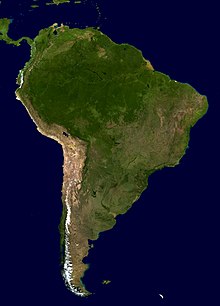
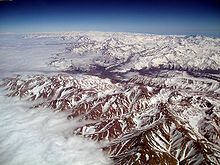
South America occupies the southern portion of the landmass sometimes referred to as the New World. The continent is generally delimited on the northwest by the Darién watershed along the Colombia–Panama border, or (according to some sources) by the Panama Canal which transects the Isthmus of Panama. Geopolitically and geographically[4] all of Panama – including the segment east of the Panama Canal in the isthmus – is typically included in North America alone[5][6][7] and among the countries of Central America.[8][9] Almost all of mainland South America sits on the South American Plate.
Many of the islands of the Caribbean (or West Indies) – e.g., the Leeward and Lesser Antilles – sit atop the Caribbean Plate, a tectonic plate with a diffuse topography. The islands of Aruba, Barbados, Trinidad, and Tobago sit on the northerly South American continental shelf. The Netherlands Antilles and the federal dependencies of Venezuela lie along the northerly South American shelf. Geopolitically, the island states and overseas territories of the Caribbean are generally grouped as a part or subregion of North America.[7][10][11] The South American nations that border the Caribbean Sea—including Colombia, Venezuela, Guyana, Suriname, and French Guiana—are also known as Caribbean South America. Other islands are the Galápagos islands that belong to Ecuador and Easter Island (in Oceania but belongs to Chile), Robinson Crusoe Island, Chiloé, and the Tierra del Fuego.
South America is home to the world's highest waterfall, Angel Falls in Venezuela; the largest river (by volume), the Amazon River; the longest mountain range, the Andes (whose highest mountain is Aconcagua at 6,962 m [22,841 ft]); the driest place on earth, the Atacama Desert;[12][13][14] the largest rainforest, the Amazon Rainforest; the highest capital city, La Paz, Bolivia; the highest commercially navigable lake in the world, Lake Titicaca; and, excluding research stations in Antarctica, the world's southernmost permanently inhabited community, Puerto Toro, Chile.
South America's major mineral resources are gold, silver, copper, iron ore, tin, and petroleum. The many resources of South America have brought high income to its countries especially in times of war or of rapid economic growth by industrialized countries elsewhere. However, the concentration in producing one major export commodity often has hindered the development of diversified economies. The fluctuation in the price of commodities in the international markets has led historically to major highs and lows in the economies of South American states, often causing extreme political instability. This is leading to efforts to diversify production to drive away from staying as economies dedicated to one major export.
South America is one of the most biodiverse continents on earth. South America is home to many interesting and unique species of animals including the llama, anaconda, piranha, jaguar, vicuña, and tapir. The Amazon rainforests possess high biodiversity, containing a major proportion of the Earth's species. Regions in South America include the Andean States, the Guianas, the Southern Cone, and Brazil which is the largest country by far, in both area and population.
History
Agriculture and animal domestication
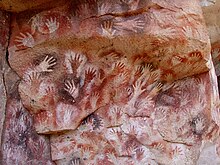
South America is thought to have been first inhabited by people crossing the Bering Land Bridge (now the Bering Strait) from the territory that is present-day Russia. Some archaeological finds do not fit this theory and have led to an alternative theory of Pre-Siberian American Aborigines. The first evidence for the existence of agricultural practices in South America dates back to about 6500 BC, when potatoes, chillies and beans began to be cultivated for food in the highlands of the Amazon Basin. Pottery evidence further suggests that manioc, which remains a staple food today, was being cultivated as early as 2000 BC.[15]
By 2000 BC, many agrarian village communities had been settled throughout the Andes and the surrounding religious regions. Fishing became a widespread practice along the coast, helping establish fish as a primary source of food. Irrigation systems were also developed at this time, which aided in the rise of an agrarian society.[15]
South American cultures began domesticating llamas, vicuñas, guanacos, and alpacas in the highlands of the Andes circa 3500 BC. Besides their use as sources of meat and wool, these animals were used for transportation of goods.[15]
Pre-Columbian civilizations
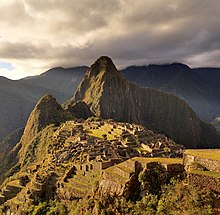
The rise of plant growing and the subsequent appearance of permanent human settlements allowed for the multiple and overlapping beginnings of civilizations in South America.
The earliest known settlements, and culture in South America and America altogether, are the Valdivia on the Southwest coast of Ecuador.
One of the earliest known South American civilizations was at Norte Chico, on the central Peruvian coast. Though a pre-ceramic culture, the monumental architecture of Norte Chico is contemporaneous with the pyramids of Ancient Egypt. Norte Chico governing class established a trade network and developed agriculture then followed by Chavín by 900 BC, according to some estimates and archaeological finds. Artifacts were found at a site called Chavín de Huantar in modern Peru at an elevation of 3,177 meters. Chavín civilization spanned 900 BC to 300 BC.
In the central coast of Peru, around the beginning of the I millennium AD, Moche (100 BC – 700 AD, at the northern coast of Peru), Paracas and Nazca (400 BC – 800 AD, Peru) cultures flourished with centralized states with permanent militia improving agriculture through irrigation and new styles of ceramic art. At the Altiplano, Tiahuanaco or Tiwanaku (100 BC – 1200 AD, Bolivia) managed a large commercial network based on religion.
Around 7th century, both Tiahuanaco and Wari or Huari Empire (600 – 1200, Central and northern Peru) expanded its influence to all the Andean region, imposing the Huari urbanism and tiahuanaco religious iconography.
The Muisca were the main indigenous civilization in what is now modern Colombia. They established a confederation of many clans, or cacicazgos, that had a free trade network among themselves. They were goldsmiths and farmers.
Other important Pre-Columbian cultures include: ; the Cañaris (in south central Ecuador), Chimu Empire (1300–1470, Peruvian northern coast), Chachapoyas, and the Aymaran kingdoms (1000–1450, Bolivia and southern Peru).
Holding their capital at the great city of Cusco, the Inca civilization dominated the Andes region from 1438 to 1533. Known as Tawantin suyu, and "the land of the four regions," in Quechua, the Inca civilization was highly distinct and developed. Inca rule extended to nearly a hundred linguistic or ethnic communities, some 9 to 14 million people connected by a 25,000 kilometer road system. Cities were built with precise, unmatched stonework, constructed over many levels of mountain terrain. Terrace farming was a useful form of agriculture.
The Mapuche in Central Chile were known for defenses against European and later Chilean settlers in the first 300 years of the Columbian period. [citation needed]
European colonization


In 1494, Portugal and Spain, the two great maritime European powers of that time, on the expectation of new lands being discovered in the west, signed the Treaty of Tordesillas, by which they agreed, with the support of the Pope, that all the land outside Europe should be an exclusive duopoly between the two countries.
The Treaty established an imaginary line along a north-south meridian 370 leagues west of Cape Verde Islands, roughly 46° 37' W. In terms of the treaty, all land to the west of the line (known to comprise most of the South American soil) would belong to Spain, and all land to the east, to Portugal. As accurate measurements of longitude were impossible at that time, the line was not strictly enforced, resulting in a Portuguese expansion of Brazil across the meridian.
Beginning in the 1530s, the people and natural resources of South America were repeatedly exploited by foreign conquistadors, first from Spain and later from Portugal. These competing colonial nations claimed the land and resources as their own and divided it into colonies.
European infectious diseases (smallpox, influenza, measles, and typhus)—to which the native populations had no immune resistance—and systems of forced labor, such as the haciendas and mining industry's mita, decimated the native population under Spanish control. After this, African slaves, who had developed immunities to these diseases, were quickly brought in to replace them.
The Spaniards were committed to convert their native subjects to Christianity and were quick to purge any native cultural practices that hindered this end; however, most initial attempts at this were only partially successful, as native groups simply blended Catholicism with traditional idolatry and their polytheistic beliefs. Furthermore, the Spaniards brought their language to the degree they did with their religion, although the Roman Catholic Church's evangelization in Quechua, Aymara, and Guaraní actually contributed to the continuous use of these native languages albeit only in the oral form.
Eventually, the natives and the Spaniards interbred, forming a mestizo class. At the beginning, the mestizos of the Andean region were offspring of Amerindian mothers and Spanish fathers. After independence, most mestizos had native fathers and white or mestizo mothers.
Many native artworks were considered pagan idols and destroyed by Spanish explorers; this included many gold and silver sculptures and other artifacts found in South America, which were melted down before their transport to Spain or Portugal. On the other hand, Spaniards and Portuguese brought the western architectural style to the continent as well as they helped to improve infrastructures like bridges, roads, and the sewer system of the cities they discovered, conquered or found. They also significantly improved economic and trade relations, not just between the old and new world but between the different South American regions and peoples. Finally, with the expansion of the Portuguese and Spanish languages, many cultures that were previously separated became united through that of Latin American.
Guyana was a Portuguese, Dutch, and eventually a British colony. The country was once partitioned into three parts, each being controlled by one of the colonial powers until the country was finally taken over fully by the British.
Independence
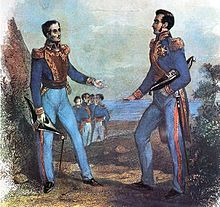
The South American possessions of the Spanish Crown won their independence between 1804 and 1826 in the Spanish American wars of independence. Simón Bolívar of Venezuela and José de San Martín of Argentina were the most important leaders of the independence struggles. Bolívar led a great uprising in northern South America, then led his army southward towards Lima, the capital of the Viceroyalty of Peru. Meanwhile, San Martín led an army from the Viceroyalty of Rio de la Plata across the Andes Mountains, meeting up with General Bernardo O'Higgins in Chile, and then marched northward to gain the military support of various rebels from the Viceroyalty of Peru. The two armies finally met in Guayaquil, Ecuador, where they cornered the Royal Army of the Spanish Crown and forced its surrender.
In the Portuguese colony of Brazil, Dom Pedro I (also Pedro IV of Portugal), son of the Portuguese King Dom João VI, proclaimed the country's independence in 1822 and became Brazil's first Emperor. After some quarreling with Portuguese loyal garrisons in Bahia and Pará, this was diplomatically accepted by the crown in Portugal, on conditions of a high compensation paid by Brazil.
Although Bolivar attempted to unify politically the Spanish-speaking parts of the continent into the "Gran Colombia", they rapidly became independent states without political connections between them, despite some later attempts such as the Peruvian-Bolivian Confederation.
A few countries did not gain independence until the 20th century:
- Guyana, from the United Kingdom, in 1966
- Suriname, from Dutch control, in 1975
French Guiana is now a region of France.
The Falkland Islands remain sovereign territory of the United Kingdom.
South Georgia and South Sandwich Islands also remain sovereign territory of the United Kingdom.
Recent history
The continent became a battlefield of the Cold War in the late 20th century. Some democratically elected governments of Argentina, Brazil, Chile, Uruguay and Paraguay were overthrown or displaced by United States-aligned military dictatorships in the 1960s and 1970s. Many of those dictators, genocides and torturers were trained in violation of human rights by the United States in the infamous School of the Americas. To curtail opposition, their governments detained tens of thousands of political prisoners, many of whom were tortured and/or killed on inter-state collaboration. Economically, they began a transition to neoliberal economic policies. They placed their own actions within the U.S. Cold War doctrine of "National Security" against internal subversion. Throughout the 1980s and 1990s, Peru suffered from an internal conflict.
Argentina and Britain fought the Falklands war in 1982.
Colombia currently faces an internal conflict, which started in 1964 with the creation of Marxist guerrillas (FARC-EP) and now involves several illegal armed groups of leftist leaning ideology as well as the private armies of powerful drug lords.
Revolutionary movements and right-wing military dictatorships became common after World War II, but since the 1980s a wave of democratization came through the continent, and democratic rule is widespread now.[16] Nonetheless, allegations of corruption are still very common, and several countries have developed crises which have forced the resignation of their governments, although, in most occasions, regular civilian succession has continued this far.
International indebtedness turned into a severe problem in late 1980s, and some countries, despite having strong democracies, have not yet developed political institutions capable of handling such crises without recurring to unorthodox economical policies, as most recently illustrated by Argentina's default in the early 21st century.[17]
Politics

During the first decade of the 21st century, South American governments have drifted to the political left, with socialist leaders being elected in Chile, Uruguay, Brazil, Argentina, Ecuador, Bolivia, Paraguay and Venezuela. Despite the move to the left, South America for the most part still embraces free market policies, and it is taking an active path toward greater continental integration.
Recently, an intergovernmental entity has been formed which aims to merge the two existing customs unions: Mercosur and the Andean Community, thus forming the third-largest trade bloc in the world.[18] This new political organization known as Union of South American Nations seeks to establish free movement of people, economic development, a common defense policy and the elimination of tariffs.
Demographics
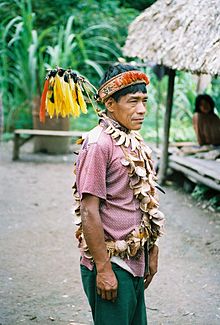
Descendants of Indigenous peoples, such as the Quechua and Aymara, or the Urarina[19] of Amazonia make up the majority of the population in Bolivia (55%) and, per some sources, in Peru (45%).[20][21] In Ecuador, Amerindians are a large minority that comprises two-fifths of the population. The white/European population is also a significant element in most other former Spanish colonies.
The demographics of Venezuela and Colombia include approximately 25% white and European descendants.,[22] while in Peru, European descendants are the third group in importance(15%).[23] Compared to other South American countries, the people of European descent are more of a majority in Argentina,[24] Chile,[25][26] and Uruguay,[27] and form a large component of the "mixed race" populations of Brazil.[28][29][30]
South America is also home to one of the biggest population of Africans. This group is also significantly present in Guyana, Brazil, Colombia, Venezuela, Suriname, French Guiana, and Ecuador.[31] Mestizos (mixed white and Amerindian) are the largest ethnic group in Paraguay, Venezuela, Colombia and Ecuador and the second group in Peru. East Indians form the largest ethnic groups in Guyana and Suriname. Brazil followed by Peru also have the biggest Japanese and Chinese communities in South America.[32]
Brazil is the most diverse country in South America, with large population of Whites, Blacks, Mestizos and Mulattos, as well as a sizeable community of Middle Easterners and East Asians.
Indigenous peoples
Indigenous people make up about half of the population of Peru and Bolivia. In many places indigenous people still practice a traditional lifestyle based on subsistense agriculture or as hunter-gatherers. There are still some uncontacted tribes residing in the Amazon Rainforest.
In countries such as Chile, Colombia, Venezuela, Brazil and Argentina indigenous peoples make up a minority of the population.
- Alacalufe
- Atacameños
- Aymara - lives in the Altiplano of Bolivia, Chile and Peru. Their language is co-official in Peru and Bolivia. Traditional lifestyle includes llama herding.
- Awá
- Aguarunas
- Ashanincas
- Banawa
- Cañaris
- Caiapos
- Chibcha
- Cocama
- Chayahuita, Enxet
- Gê,
- Guaraní - lives in Paraguay where Guarani language is co-official with Spanish
- Juris
- Mapuche - lives mainly in southern Chile and adjacent pockets of Argentina.
- Matsés
- Pehuenche - a branch of Mapuches that lived in the Andean valleys of southern Chile
- Quechuas - makes up a large part of the population of Peru, Ecuador and Bolivia. Are diverse as an ethnic group. The Incas spoke Southern Quechua.
- Selknam
- Shipibo
- Shuar, Tupi, Xucuru, Urarina, Wayuu, Yaghan
- Yagua
- Yąnomamö
- Zaparos
- Arawaks,
- Wai-Wai
Economy
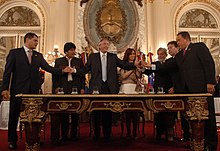
During the last two decades, South American countries have experienced significant economic growth, which can be seen in many of these countries with the construction of new skyscrapers like the Gran Costanera tower in Chile, and also transportations systems like the Bogota Metro. However, because of histories of high inflation in nearly all South American countries, interest rates remain high and investment remains low. Interest rates are usually twice that of the United States. For example, interest-rates are about 22% in Venezuela and 23% in Suriname. The exception is Chile, which has been implementing free market economic policies since establishing military dictatorship in 1973 and has been increasing its social spending since the return of democratic rule in the early 1990s. This has led to economic stability and interest rates in the low single digits.
South America relies heavily on the exporting of goods and natural resources. On an exchange rate basis Brazil (the seventh largest economy in the world and the largest in South America) leads the way in total amount of exports at $137.8 billion dollars followed by Chile at 58.12 billion and Argentina with 46.46 billion.[40]
The economic gap between the rich and poor in most South American nations is considered to be larger than in most other continents. In Venezuela, Paraguay, Bolivia and many other South American countries, the richest 20% may own over 60% of the nation's wealth, while the poorest 20% may own less than 5%. This wide gap can be seen in many large South American cities where makeshift shacks and slums lie adjacent to skyscrapers and upper-class luxury apartments.
| Country | GDP (nominal) of 2009[41] | GDP (PPP) of 2009[42] | GDP (PPP) per capita of 2009[42] | HDI of 2009[43] | |
|---|---|---|---|---|---|
| 326,474 | 572,860 | 14,413 | 0.775 | ||
| 17,413 | 43,424 | 4,330 | 0.643 | ||
| 1,574,039 | 2,013,186 | 10,513 | 0.699 | ||
| 169,573 | 243,044 | 14,510 | 0.783 | ||
| 319,654 | 456,300 | 8,215 | 0.689 | ||
| 52,572 | 106,993 | 7,685 | 0.695 | ||
| ? | 75 | 25,000 | N/A | ||
| N/A | N/A | ||||
| 1,130 | 3,082 | 4,035 | 0.611 | ||
| 16,006 | 29,403 | 4,778 | 0.640 | ||
| 127,598 | 245,883 | 8,723 | 0.723 | ||
| 2,984 | 4,436 | 8,323 | 0.646 | ||
| 32,262 | 42,543 | 13,294 | 0.765 | ||
| 319,443 | 335,200 | 12,785 | 0.696 | ||

Largest economic cities in South America 2008
| Rank | City | Country | GDP in $ID BN[44] | Population (MIL) |
|---|---|---|---|---|
| 1 | São Paulo | $ 388 | 18.845 | |
| 2 | Buenos Aires | $ 362 | 12.795 | |
| 3 | Rio de Janeiro | $ 201 | 11.748 | |
| 4 | Santiago | $ 112 | 5.701 | |
| 5 | Brasilia | $ 110 | 3.451 |
Tourism

Tourism has increasingly become a significant source of income for many South American countries.[45][46] Historical relics, architectural and natural wonders, a diverse range of foods and culture, vibrant and colorful cities, and stunning landscapes attract millions of tourists every year to South America. Some of the most visited places in the region are Machu Picchu, the Amazon Rainforest, Rio de Janeiro, Salvador, Fortaleza , Maceió, Lima, Florianópolis, Isla Margarita, Natal, Buenos Aires, São Paulo, Angel Falls, Cuzco, Lake Titicaca, Patagonia, Cartagena and the Galápagos islands.[47][48]
Culture

South Americans are culturally influenced by the historic connection with Europe, especially Spain and Portugal, and the impact of mass culture from the United States of America.
South American nations have a rich variety of music. Some of the most famous genres include vallenato and cumbia from Colombia, samba and bossa nova from Brazil, and tango from Argentina and Uruguay. Also well known is the non-commercial folk genre Nueva Canción movement which was founded in Argentina and Chile and quickly spread to the rest of the Latin America. People on the Peruvian coast created the fine guitar and cajon duos or trios in the most mestizo (mixed) of South American rhythms such as the Marinera (from Lima), the Tondero (from Piura), the 19th century popular Creole Valse or Peruvian Valse, the soulful Arequipan Yaravi, and the early 20th century Paraguayan Guarania. In the late 20th century, Spanish rock emerged by young hipsters influenced by British pop and American rock. Brazil has a Portuguese-language pop rock industry as well a great variety of other music genres.
The literature of South America has attracted considerable critical and popular acclaim, especially with the Latin American Boom of the 1960s and 1970s, and the rise of authors such as Mario Vargas Llosa, Gabriel García Márquez in novels, and Pablo Neruda and Jorge Luis Borges in other genres. The Brazilian Machado de Assis, a 19th century realist writer, widely regarded as the greatest writer of Brazilian literature has among the admirers of his unique style, names such as José Saramago, Carlos Fuentes, Susan Sontag and Harold Bloom.
Because of South America's broad ethnic mix, South American cuisine takes on African, American Indian, Asian, and European influences. Bahia, Brazil, is especially well-known for its West African–influenced cuisine. Argentines, Chileans, Uruguayans, Brazilians and Venezuelans regularly consume wine, while Argentina along with Paraguay, Uruguay, and people in southern Chile and Brazil enjoy mate, a regional brewed herb cultivated for its drink, the Paraguayan version, terere, differing from the others in that it is served cold. Pisco is a liquor distilled from grapevine produced in Peru and Chile. Peruvian cuisine mixes elements from Chinese, Japanese, Spanish, African, Andean, and Amazonic food.
Language

Spanish (193,243,411 speakers)[49] and Portuguese (193,197,164)[50] are the most spoken languages in South America. Spanish is the official language of most countries, along with other native languages in some countries. Spanish is also taught in Brazil, being the most spoken language as a first, second and third language in South America. Portuguese is the official language of Brazil. Dutch is the official language of Suriname; English is the official language of Guyana, although there are at least twelve other languages spoken in the country such as Hindi and Arabic. English is also spoken in the Falkland Islands. French is the official language of French Guiana and the second language in Amapa (Brazil).
Indigenous languages of South America include Quechua in Ecuador, Peru, Chile, Argentina, and Bolivia; Guaraní in Paraguay and, to a much lesser extent, in Bolivia; Aymara in Bolivia, Peru, and less often in Chile; and Mapudungun is spoken in certain pockets of southern Chile and, more rarely, Argentina. At least three South American indigenous languages (Quechua, Aymara, and Guarani) are recognized along with Spanish as national languages.
Other languages found in South America include, Hindi and Indonesian in Suriname; Italian in Argentina, Brazil, Uruguay, Venezuela, Peru and Chile; and German in certain pockets of Argentina, Brazil, Chile, Venezuela, Peru and Paraguay. German is also spoken in many regions of the southern states of Brazil, Riograndenser Hunsrückisch being the most widely spoken German dialect in the country; among other Germanic dialects, a Brazilian form of Pomeranian is also well represented and is experiencing a revival. Welsh remains spoken and written in the historic towns of Trelew and Rawson in the Argentine Patagonia. There are also small clusters of Japanese-speakers in Brazil and Peru. Arabic speakers, often of Lebanese, Syrian, or Palestinian descent, can be found in Arab communities in Brazil, Ecuador, Peru, Chile, Argentina, and less frequently in Colombia and Paraguay.
In most of the continent's countries, the upper classes and well-educated people regularly study English, French, German, or Italian, and are typically well-traveled. In those areas where tourism is a significant industry, English and some other European languages are often spoken. There are small Portuguese speaking areas in northernmost Uruguay because of the proximity of Brazil, as well a small Spanish speaking minority in the other side in southernmost Brazil. [citation needed]
Sport
See also
- Americas (terminology)
- Bibliography of South America
- Flags of South America
- South American capital cities
References
Content notes
^ Continent Model: In some parts of the world South America is viewed as a subcontinent of America[51][52] (a single continent in these areas), for example Latin America, Latin Europe, and Iran. In most of the countries with English as an official language, however, it is considered a continent.
See Continent.
Notes
- ^ American, Merriam-Webster OnLine.
- ^ "South America. The Columbia Encyclopedia, 6th ed. 2001–6. New York, Columbia University Press": "fourth largest continent ..., the southern of the two continents of the Western Hemisphere."
- ^ "LANIC country page". Lanic.utexas.edu. Retrieved 2010-10-24.
- ^ Cohen, Saul Bernard. 2003. "North and Middle America" (Ch. 5). Geopolitics of the World System (ISBN 0847699072)
- ^ "Americas" Standard Country and Area Codes Classifications (M49), United Nations Statistics Division
- ^ "North America" Atlas of Canada
- ^ a b North America Atlas National Geographic
- ^ "Panama". Britannica Concise Encyclopedia
- ^ Geography: Panama CIA World Factbook 2008.
- ^ South America Atlas National Geographic
- ^ Unstats Americas
- ^ "Atacama Desert @ National Geographic Magazine". Ngm.nationalgeographic.com. Retrieved 2009-04-18.
- ^ "Driest Place | Driest Desert Atacama Desert". Extremescience.com. 2007-01-25. Retrieved 2009-04-18.
- ^ http://quest.nasa.gov/challenges/marsanalog/egypt/AtacamaAdAstra.pdf
- ^ a b c O'Brien, Patrick. (General Editor). Oxford Atlas of World History. New York: Oxford University Press, 2005. pp. 25
- ^ "The Cambridge History of Latin America", edited by Leslie Bethell, Cambridge University Press (1995) ISBN 0-521-39525-9
- ^ The Cambridge History of Latin ... - Google Books. Books.google.com. Retrieved 2010-10-24.
- ^ "Globalpolicy.org". Globalpolicy.org. 2008-10-29. Retrieved 2010-10-24.
- ^ Dean, Bartholomew 2009 Urarina Society, Cosmology, and History in Peruvian Amazonia, Gainesville: University Press of Florida ISBN 978-0813033785 [1]
- ^ "CIA World Factbook". Cia.gov. Retrieved 2009-04-18.
- ^ "CIA World Factbook". Cia.gov. Retrieved 2009-04-18.
- ^ Composición Étnica de las Tres Áreas Culturales del Continente Americano al Comienzo del Siglo XXI. Books.google.cl. Retrieved 2010-10-24.
- ^ "LA Road Show". Fppmedia.com. Retrieved 2010-10-24.
- ^ "CIA World Factbook". Cia.gov. Retrieved 2009-04-18.
- ^ "Argentina, como Chile y Uruguay, su población está formada casi exclusivamente por una población blanca e blanca mestiza procedente del sur de Europa, más del 90% E. García Zarza, 1992, 19". Geografia.fflch.usp.br. Retrieved 2009-04-18.
- ^ Genetic epidemiology of single gene defects in Chile.[dead link]
- ^ "población blanca en Uruguay". Geografia.fflch.usp.br. Retrieved 2009-04-18.
- ^ População residente por situação, sexo e grupos de idade"
- ^ "Latinoamerica" (PDF). Retrieved 2010-10-24.
- ^ "The Chilean population is rather homogeneous with 95.4 % of its population having European ancestors". Studentsgoabroad.com. 1973-09-11. Retrieved 2010-10-24.
- ^ "Bartleby". Bartleby. Retrieved 2009-04-18.
- ^ "Japan Times". Search.japantimes.co.jp. Retrieved 2009-04-18.
- ^ a b Land areas and population estimates are taken from The 2008 World Factbook which currently uses July 2007 data, unless otherwise noted.
- ^ La Paz is the administrative capital of Bolivia;
- ^ Includes Easter Island in the Pacific Ocean, a Chilean territory frequently reckoned in Oceania. Santiago is the administrative capital of Chile; Valparaíso is the site of legislative meetings.
- ^ Claimed by Argentina.
- ^ Falkland Islands: July 2008 population estimate. CIA World Factbook.
- ^ (Jan. 2009) Template:Fr icon INSEE, Government of France. "Population des régions au 1er janvier". Retrieved 2009-01-20.
- ^ Claimed by Argentina; the South Georgia and the South Sandwich Islands in the South Atlantic Ocean are commonly associated with Antarctica (due to proximity) and have no permanent population, only hosting a periodic contingent of about 100 researchers and visitors.
- ^ "CIA - The World Factbook - Rank Order - Exports". Cia.gov. 2009-04-09. Retrieved 2009-04-18.
- ^ "Source" (PDF). Retrieved 2010-10-24.
- ^ a b Source
- ^ "Human Development Report 2009. Human development index trends: Table G" (PDF). The United Nations. Retrieved 2009-10-05.
- ^ "Global city GDP rankings 2008-2025". Pricewaterhouse Coopers. Retrieved 31 July 2010.
- ^ "Bigtravelweb". Bigtravelweb. 2008-10-13. Retrieved 2009-04-18.
- ^ Latin American tourism growth
- ^ "Top attractions". Gosouthamerica.about.com. 2007-12-04. Retrieved 2009-04-18.
- ^ Backpackers destination[dead link]
- ^ Based on recent estimates, as of 2010. Sources by country: Argentina "Proyecciones provinciales de población por sexo y grupos de edad 2001–2015" (PDF). Gustavo Pérez. INDEC. Retrieved 2008-06-24.
{{cite web}}: Unknown parameter|formato=ignored (|format=suggested) (help); Unknown parameter|idioma=ignored (|language=suggested) (help); Unknown parameter|páginas=ignored (|pages=suggested) (help); Bolivia "Bolivia". World Gazetteer. Retrieved 2010-01-07.; Colombia "Departamento Administrativo Nacional de Estadística". Dane.gov.co. Retrieved 2010-05-16.; Ecuador Department of Economic and Social Affairs Population Division (2009). [_text_tables.pdf "World Population Prospects, Table A.1"] (PDF). 2008 revision. United Nations. Retrieved 2009-03-12.{{cite journal}}: Check|url=value (help); Cite journal requires|journal=(help); Paraguay Department of Economic and Social Affairs Population Division (2009). "World Population Prospects, Table A.1" (PDF). 2008 revision. United Nations. Retrieved 2009-03-12.{{cite journal}}: Cite journal requires|journal=(help); Peru Instituto Nacional de Estadística e Informática (INEI) del PerúINEI. Retrieved on June 10, 2010; Uruguay Central Intelligence Agency. "Uruguay". The World Factbook. Retrieved January 5, 2010. - ^ "Estimativas da População".
- ^ "South America Travel, Tour To South America Continent". Retrieved 2007-05-19.
- ^ Ambassador Rubens A. Barbosa. "MERCOSUL IN THE REGIONAL CONTEXT". Retrieved 2007-05-19.
Sources
- "South America". The Columbia Gazetteer of the World Online. 2005. New York: Columbia University Press.
- GeoHive: The population of continents, regions and countries
- Latin American Network Information Database












